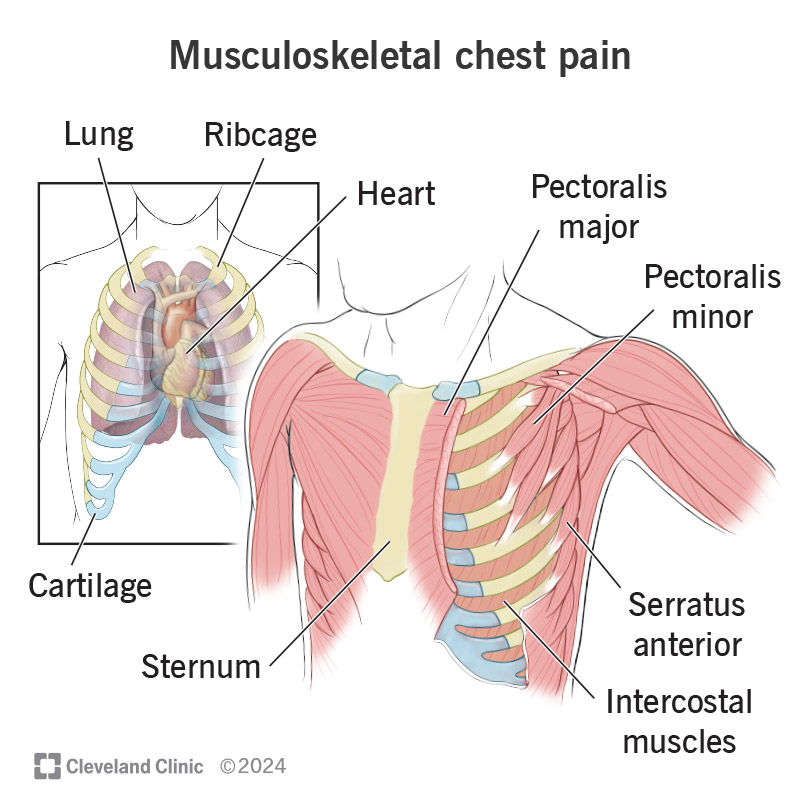Musculoskeletal chest pain comes from the bones, muscles and tissues that enclose your heart — known as your chest wall. Pain from these structures isn’t the same as angina (cardiac pain), though it’s not always easy to tell the difference.
Advertisement
Cleveland Clinic is a non-profit academic medical center. Advertising on our site helps support our mission. We do not endorse non-Cleveland Clinic products or services. Policy

Musculoskeletal chest pain is pain in your chest wall, the framework of muscles and bones that encloses your heart and lungs. Muscles, bones and connective tissues make up your musculoskeletal system.
Advertisement
Cleveland Clinic is a non-profit academic medical center. Advertising on our site helps support our mission. We do not endorse non-Cleveland Clinic products or services. Policy
Musculoskeletal chest pain might involve:
It can be hard to tell exactly where chest pain is coming from when you’re having it. But musculoskeletal pain in your chest has different qualities from typical chest pain, which might be related to your heart.
Musculoskeletal conditions and cardiac (heart-related) conditions are both common causes of chest pain that bring people to the hospital. Nevertheless, cardiac chest pain is considered “typical” chest pain.
Typical chest pain:
Typical chest pain isn’t always angina, a symptom of heart disease. But you should always see a healthcare provider to be sure. Typical chest pain that isn’t angina is called noncardiac chest pain.
Chest pain that doesn’t resemble angina is called atypical chest pain. Musculoskeletal chest pain is usually “atypical” in this sense. It might have only one or none of the characteristics listed above.
Advertisement
Musculoskeletal chest pain is more likely to:
These differences can provide clues to what’s causing your chest pain. But when you’re having chest pain, it’s best to act quickly and see a healthcare provider rather than trying to sort it out on your own.
You might suspect you have musculoskeletal chest pain if your pain fits the profile, or if you think you might’ve been injured recently. But there’s no way to be sure without seeing a healthcare provider.
When in doubt, it’s always safer to get a diagnosis. It’s possible to have musculoskeletal chest pain and cardiac chest pain at the same time. It’s also possible you have a condition you don’t know about.
A healthcare provider will physically examine you to narrow down the source of your musculoskeletal pain. They’ll test your range of motion and feel for tenderness at specific points along your chest wall.
Musculoskeletal chest pain has many possible causes. Some of the most common causes are injuries, like muscle strains and rib fractures. Injury may be a sudden event or may happen gradually over time.
Besides injuries, arthritis and other rheumatic conditions can cause inflammation and pain in your chest wall. Conditions that cause chest wall pain without apparent injury are called chest wall pain syndromes.
Advertisement
Advertisement
Anxiety and depression can cause noncardiac chest pain. This type of pain doesn’t necessarily involve your musculoskeletal system, though. It might be psychosomatic, having no apparent physical cause.
But anxiety and depression can make your chest heave if, for example, you’re hyperventilating or sobbing heavily. This can make your chest sore, and if it’s frequent or severe, may cause a stress injury.
Treatment for musculoskeletal chest pain can vary, depending on the cause. Many of the common causes are temporary conditions that will heal with time and rest. Others are lifelong conditions.
Musculoskeletal pain often responds to hot or cold therapy and over-the-counter (OTC) pain relievers, like NSAIDs (nonsteroidal anti-inflammatory drugs) and acetaminophen. You can also try topical pain relief products, like patches and creams.
If your pain is severe or doesn’t improve, your healthcare provider might make other suggestions. If you have a chronic condition, like arthritis or myalgia, you might need to see a specialist (rheumatologist).
Regardless of the condition causing your pain, it’s important to avoid the activities that make it worse while you’re recovering. As your pain improves, you can slowly return to your normal activities.
Advertisement
You should always see a healthcare provider to diagnose the cause of your chest pain, especially if it’s new. They’ll carefully rule out heart-related causes before diagnosing musculoskeletal chest pain.
Your diagnosis will tell you what kind of treatment you need and if you can treat it at home. Make sure to see your provider again if your condition doesn’t improve, or if you develop new symptoms.
Any type of chest pain can be alarming, especially when you don’t know what’s causing it. But not all chest pain is related to your heart or lungs. Sometimes, it comes from your musculoskeletal system.
Musculoskeletal chest pain is usually not an emergency, but it’s still important to see a healthcare provider about it. They’ll investigate the possible causes and get you on the road to recovery.
Cleveland Clinic’s primary care providers offer lifelong medical care. From sinus infections and high blood pressure to preventive screening, we’re here for you.

Last reviewed on 06/10/2024.
Learn more about the Health Library and our editorial process.